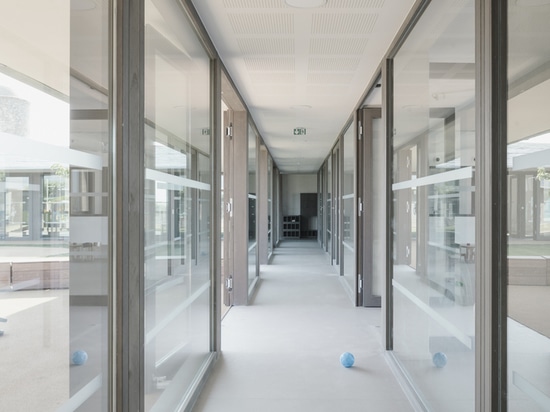
#PUBLIC ARCHITECTURE PROJECTS
Nursery in Montlaur Bonifacio / Buzzo Spinelli
Nested in the heart of the millennial citadel of Bonifacio, the Montlaur nursery is part of the military, geological, and sedimentary heritage of the city. Bordered by walls, walkways, and fortifications, the limestone plateau welcomes today a new layer to its history.
Cities have always known how to rebuild themselves. The former Montlaur military district is no exception and has just opened up to its conversion. Three limestone windmills are erect in the landscape. With these Genoese towers, the physical mighty strength is emphasized. The symbol of the cloister stands out and with its quadrilateral shape it shelters in its lair an interior garden bordered by galleries.
Lime concrete, an experimental material, refers to the identity of the citadel and its ramparts. Like Roman concrete, without cement or reinforcement, it perpetuates the phenomenon of geological stratification. The tight and artisanal ramming reminds us of the roughness and horizontal beds of the limestone cliff. The composition of the concretes was tested thoroughly, prototyped, and adjusted in order to get the right performance and aesthetic. The final result integrates the limestone aggregates of the site and the lime binder, which constitutes the DNA of the city and was formerly made in the lime kilns of the Bonifacian countryside.
The Montlaur daycare creates a powerful physical and chromatic relationship with the site on which it is anchored. The site is like a territory of experimentation with the tools used, the techniques implemented, and the coordination between masons, engineers, and even lime specialists. Proven ancestral applications, coupled with a scientific approach were at the heart of the manufacturing strategy. Rammed lime concrete in wood formwork, Genoa slate roofing, and even Laricio Pine woodwork (endemic Corsican pine) feature the short chain and the Genoese history of the city.
At the same time, those assets bring their own share of complexity in the application of artisanal techniques and raw materials, which in turn do not fit in any economics logic nowadays. However, the absence of transport, import, or ex-nihilo extraction of materials, constitutes a saving for the benefit of the traditional work. Bringing back those elementary and ancestral techniques, such as the space configuration, materiality, facade thickness, or building inertia, makes it possible again to offer promising energy-friendly air cooling options.
These processes are completed by double-sided spaces -with views of the city on one hand, and views of the interior courtyard on the other- in addition to the installation of Mediterranean wells, a floor heating system relying on a wood pellet boiler, brick walls with lime plaster, bio-sourced insulations and shutters. The microclimate of the interior garden completes the passive composition of the building with its lawn and mulberry trees which guarantee outdoor thermal comfort, generating shade in summer while allowing light to pass through in winter. These passive applications are thus no longer determined by mechanical systems, and become once again part of the architecture fundamentals, specifically for the thermal comfort of the human body.





